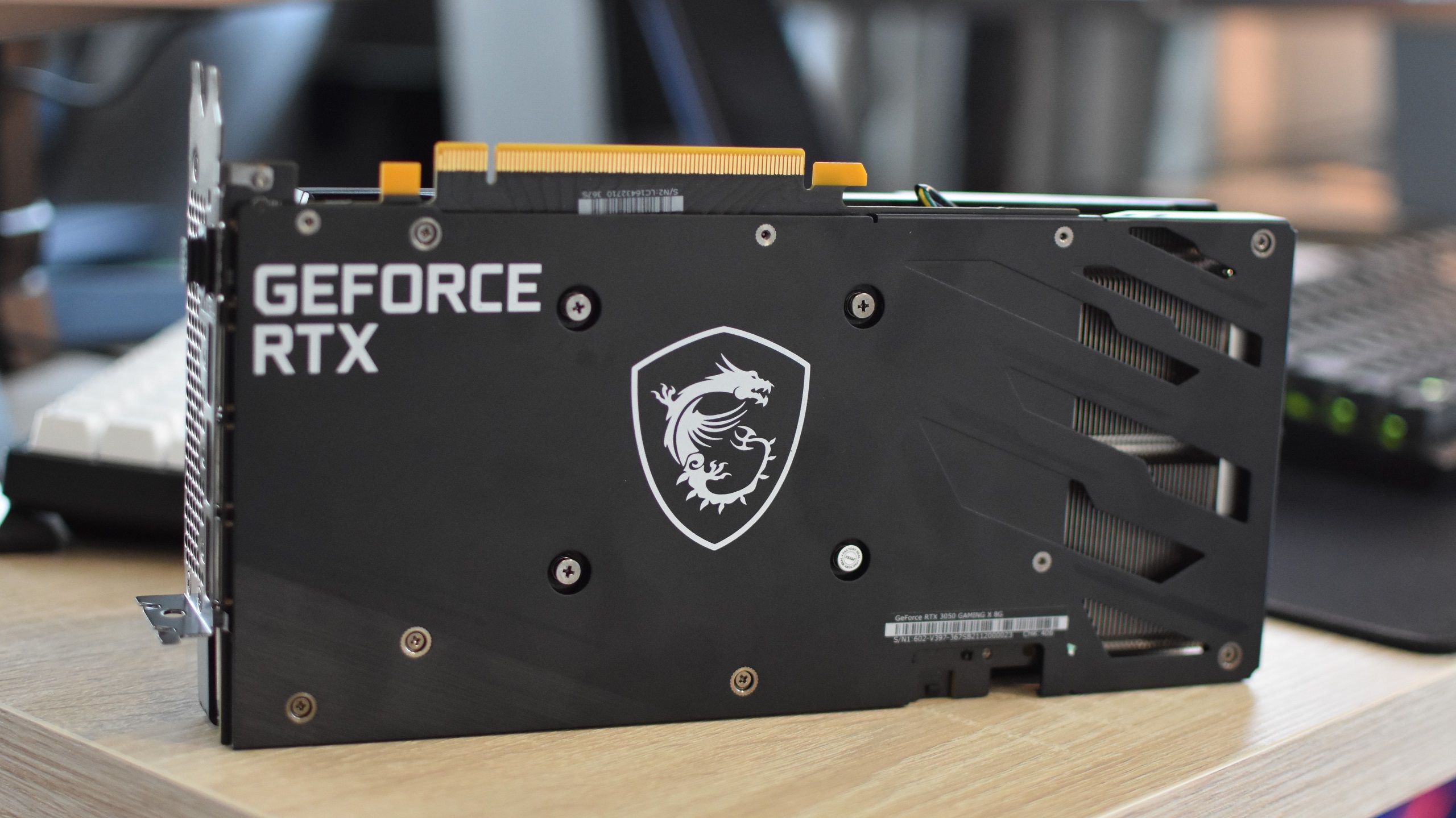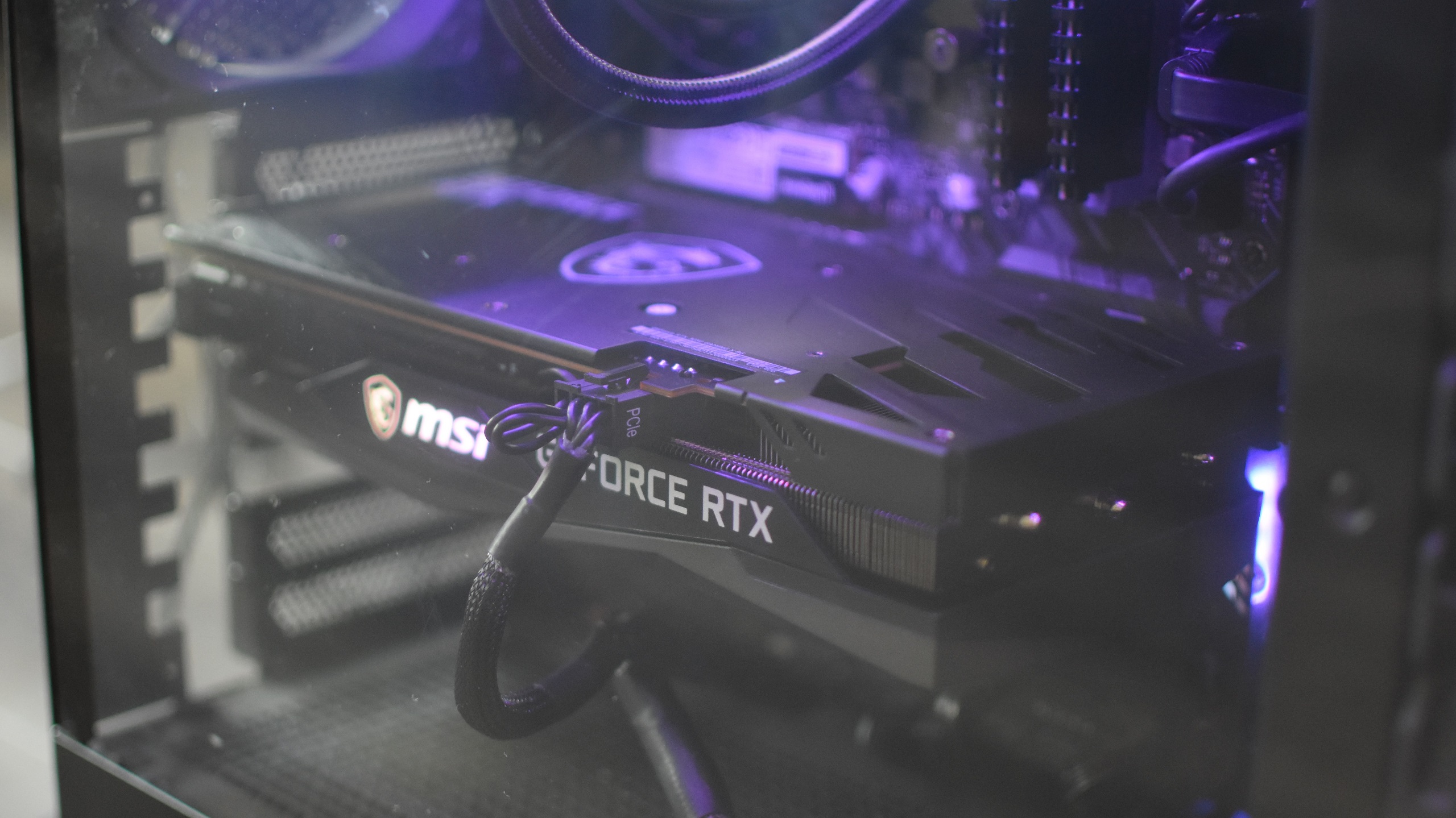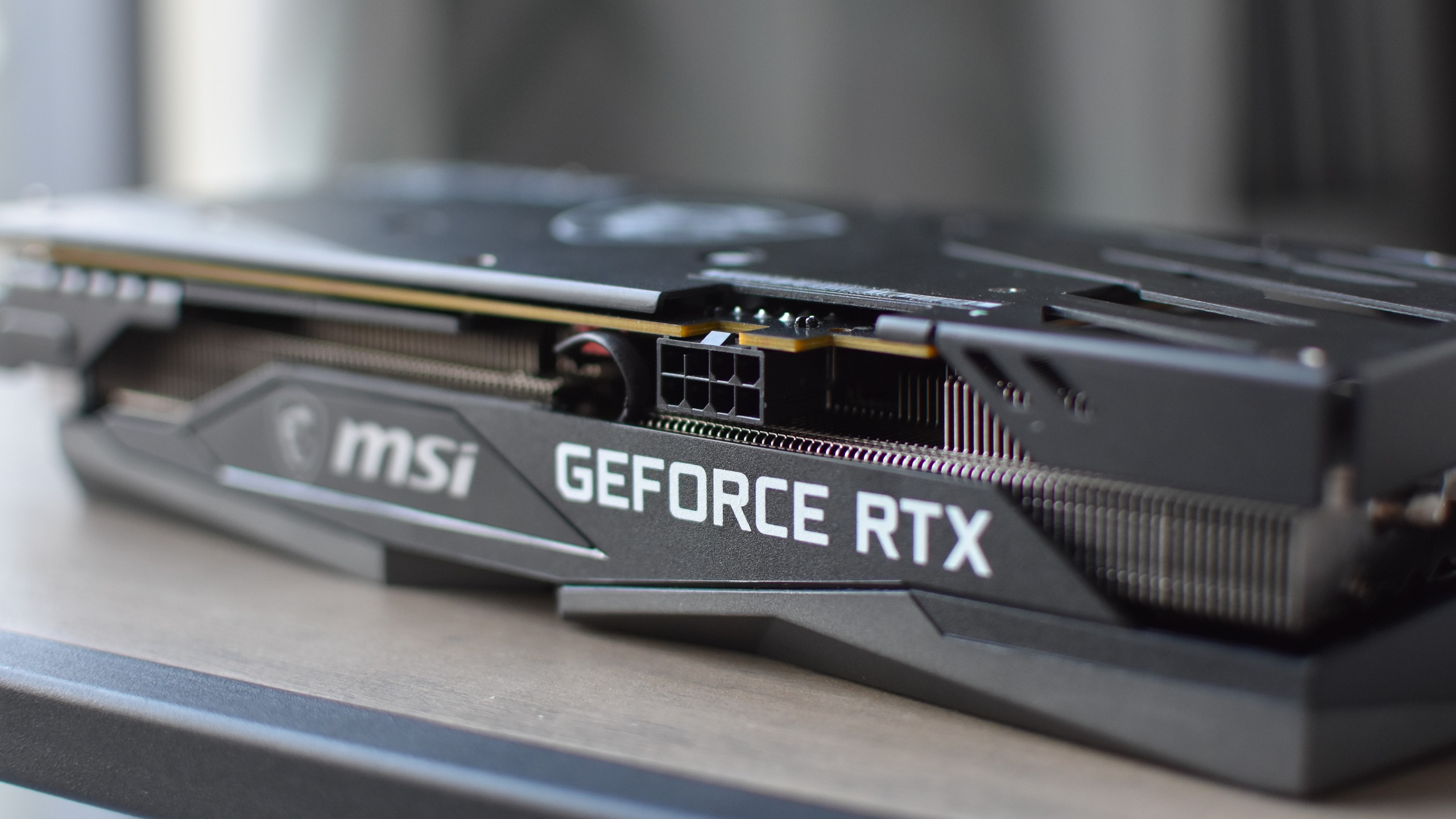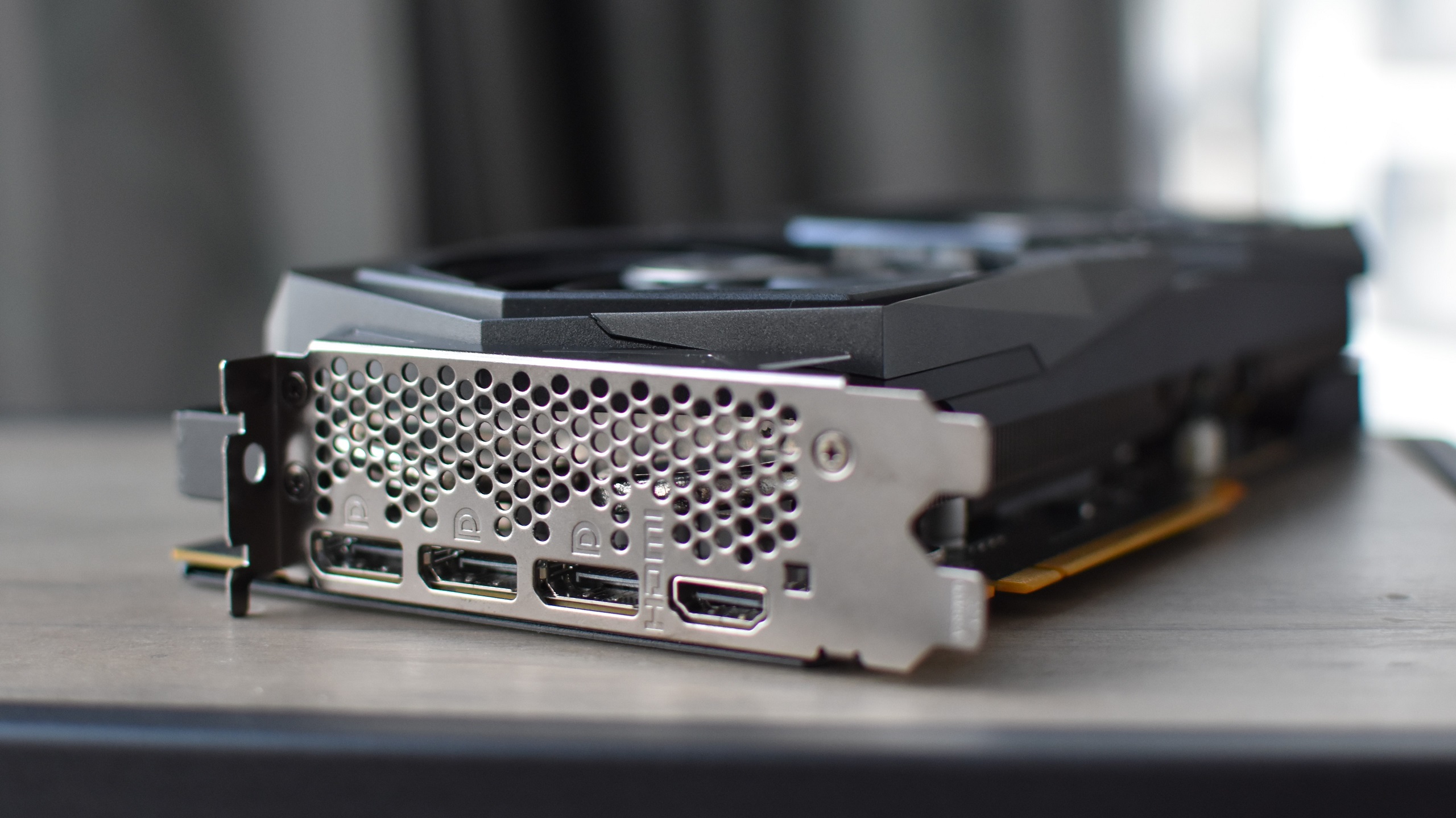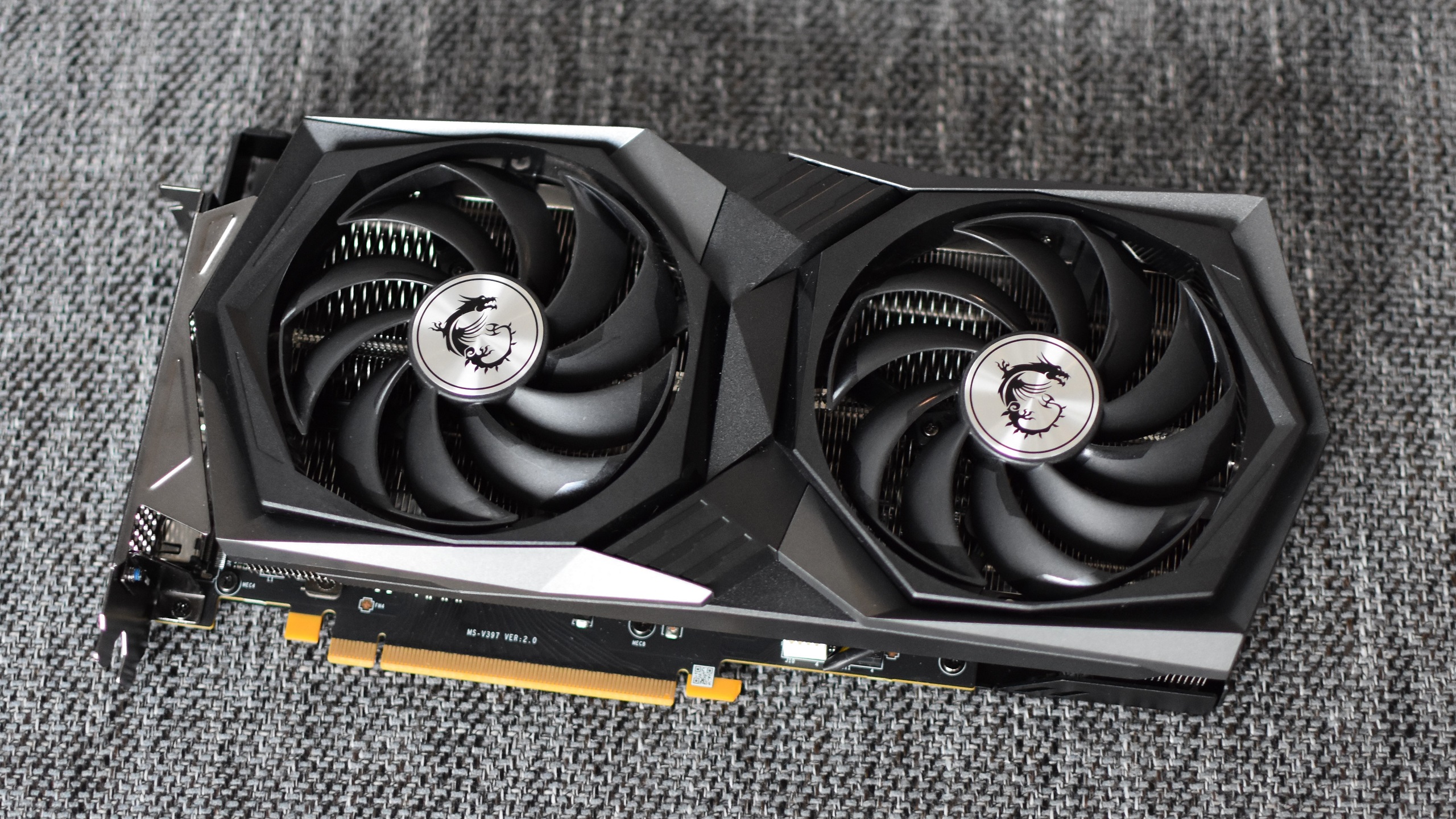And yet, these are not normal times. While the MSI GeForce RTX 3050 Gaming X 8G model I’ve tested has already ballooned to £380 / $450, this leaves it looking like much more of a genuine alternative to RTX 3060, which is generally around £500 in the UK. And while it’s ultimately still a 1080p specialist, the RTX 3050 takes a big step up from previous GTX XX50 GPUs by offering DLSS and ray tracing support. With cool, quiet running to boot, and the fact that it’s easy to find in stock, the RTX 3050 ends up as almost surprisingly viable option for new builds – even if its place among the best graphics cards is claimed partly through circumstance. Specs-wise, the move to Nvidia’s Ampere architecture gives the RTX 3050 all the same benefits as the rest of the 30 series. That means a massive rise in core count over the GTX 1650 and GTX 1650 Super, with those cores also running at higher base and boost clock speeds. The catch is that RTX 3050 is significantly thirstier for power – it’s rated for 130W, 30W more than the GTX 1650 Super – though you can still keep it sated with a lower-wattage PSU. MSI’s version also comes with some nifty customisations. Besides the factory overclocked boost clock and a tidy metal backplate, the RTX 3050 Gaming X 8G’s twin fan cooler is outstanding. It’s whisper quiet even under load, and maintained a relatively chilly 61-63 degrees Celsius during sustained benchmarking. I suspect that if prices do ever come down, these additions will preclude it dropping to the base £239 / $249, but for now it’s nice to get such premium design on a technically lower-end graphics card.
RTX 3050 performance: 1080p benchmarks
But enough about counting coins; let’s count frames instead. On its home turf of 1080p, the RTX 3050 won’t do 60fps on max settings as consistently as the RTX 3060, and certainly not the RTX 3060 Ti – but it never truly struggles either. And for those who own the best gaming monitors with heightened refresh rates, this GPU will cruise through less demanding games without sacrificing quality. Hitman 3, for example, got a 95fps average in the Dubai benchmark with Ultra-quality graphics; the more intensive Dartmoor benchmark averaged 86fps. With High settings, these results rose to 101fps and 89fps respectively. Forza Horizon 4 ain’t no thing on Ultra quality either: the RTX 3050 pumped out 119fps on average, and it would take a seriously trained pair of eyes to tell the difference between that the RTX 3060’s 135fps in the same test. In several of our test games, the RTX 3050 fell just short of 60fps on their respective maximum quality presets, only to climb back above that magic number with some tactical lowering. Both Assassin’s Creed Odyssey and Assassin’s Creed Valhalla were two such games: Odyssey’s benchmark average 50fps on Ultra High, which is still pretty smooth, then rocketed up to 82fps on High. Valhalla managed 55fps on Ultra High, then hit 64fps on High. Total War: Three Kingdoms was another, scoring 50fps in the Battle benchmark on Ultra before a switch to Medium boosted it to 119fps. Others don’t even need the help. Horizon: Zero Dawn averaged 67fps on Ultimate quality, and Shadow of the Tomb Raider even managed 60fps using both the Highest quality preset and Ultra-quality ray traced shadows. Granted, enabling this GPU’s ray tracing features won’t always have such smooth results. Metro: Exodus, for one, averaged a playable but unimpressive 36fps with Ultra quality graphics and RT effects; a visible drop from its 47fps on Ultra graphics alone. In a similar vein, switching on the fancier visual features in Final Fantasy XV devastated the frame rate, dropping from 69fps (with the Highest preset, to be fair) to 39fps with TurfEffects and Hairworks enabled. Even the old GTX 1650 didn’t take such a big hit. With ray tracing specifically, however, it’s not always asking too much of the RTX 3050. While DLSS is generally intended for use with resolutions of 1440p and above, it can be deployed at 1080p to reduce ray tracing’s performance cost. Metro Exodus is a perfect example: with DLSS on its highest setting, Quality, it completely eliminated the ray tracing tax and carried the average frame rate back up to 48fps. Even when it doesn’t wipe out the loss entirely, it’s still extremely useful to have DLSS in your pocket. Without it, Watch Dogs Legion ran at 48fps on Ultra quality – add DLSS, and that’s up to a slick 58fps. You can even add Medium-quality ray tracing and still get a playable 41fps on average. Overall, the RTX 3050 lands exactly where you’d expect it to, namely between the GTX 1650 and the RTX 3060. The latter does have a meaningful speed advantage: on our old test rig, with a slightly slower Intel Core i5-10600K, it averaged 59fps in Assassin’s Creed Valhalla, 63fps in Metro Exodus, 90fps in Horizon Zero Dawn, and 60fps in Watch Dogs Legion. That’s all at max quality, without DLSS. Still, for an extra £120, it’s also not the kind of advantage you should go out of your way for. Not at this resolution, anyway.
RTX 3050 performance: 1440p benchmarks
To the RTX 3050’s credit, it can at least run most games at max-quality 1440p – it’s just skirting the line on some of them. Three Kingdoms’ Battle benchmark, for example, just crept to 31fps on Ultra; dropping to Medium produced a dramatically smoother 73fps. Watch Dogs Legion also averaged a leisurely 36fps on Ultra quality, though another benefit of 1440p is that it’s a better fit for DLSS upscaling. With this, it managed 47fps, though throwing in Medium ray tracing bumped it down to 41fps. Final Fantasy XV, meanwhile, averaged 48fps on Highest, though adding the bonus effects still takes a heavy toll: it drops to 36fps with TurfEffects and Hairworks on. Horizon Zero Dawn fared better, averaging 53fps on Ultimate and climbing with 63fps with the addition of Quality-level DLSS. Hitman 3, too, was as smooth as 47’s head, hitting 66fps on the Dubai benchmark and 60fps in Dartmoor. Dropped from Ultra to High quality, these became 71fps and 65fps respectively. So far, so good, though again the RTX 3060 can better leverage its extra cores and memory at higher resolutions like this. Take the Assassin’s Creeds: while the RTX 3050 produced 43fps in Odyssey at Ultra High, the RTX 3060 managed 50fps, and its 47fps in Ultra High-quality Valhalla beats the RTX 3050’s 41fps. These single-digit differences don’t sound like a lot, but they can be noticeable under 60fps. The RTX 3060 also has a 10fps advantage over the RTX 3050 in Metro Exodus’ 1440p/Ultra benchmark, the latter scoring 37fps. On the bright side that’s still technically playable, and this game also provides another chance to show why the addition of DLSS is so powerful: it means you can add in Ultra-quality ray tracing, keep the rest of settings on Ultra, and still get 37fps without further drops. Without DLSS, that combo would become unplayable. DLSS also helped get Shadow of the Tomb Raider up to 78fps on the Highest preset, and although Forza Horizon 4 doesn’t support Nvidia’s upscaling tech, it doesn’t really need it, as the RTX 3050 got a healthy 95fps average on Ultra quality. As with the 1080p results, that’s lower than what the RTX 3060 can do (116fps), though the performance gap isn’t as visible up here as it is below 60fps. In super-broad terms, the RTX 3050 performs roughly on par with the RTX 2060. Normally that might result in a furrowed brow and a question of why you wouldn’t just buy the older card for less, but again, these are not normal times. For some reason – I’m assuming crypto mining nonsense – what little RTX 2060 stock is available actually costs more than the GeForce RTX 3050 Gaming X 8G, mostly tipping over £400. That brings us back, dreary as it is, to the matter of monies. A new XX50 card costing even £239 would have been unthinkable a few years ago, and if you’d told someone it was in fact £380, they’d have probably asked you to leave. Even if it was in your own house. But the even more bizarre reality is that the RTX 3050 has got off relatively easily, next to the £400 RTX 2060 and the £500 RTX 3060. Even the DLSS-deprived GTX 1650 Ti will set you back £350 or more. The 1650 Ti! For £350! Outrageous. And I’ve love to say to just wait until everything’s calmed down, so you can get the RTX 3060 at a fairer price, but between production problems and a backlog of demand that won’t be anytime soon. Thus, in the current climate the RTX 3050 may well be your best bet for building a cost-conscious that that also meets modern performance standards. It may not be the dirt-cheap wunderkind that Nvidia’s 30 series was missing, but unlike the lower-tier GPUs of the previous generation, it will grant you the magic of DLSS. On top of good 1080p performance and halfway decent 1440p power… well, there are worse deals.
